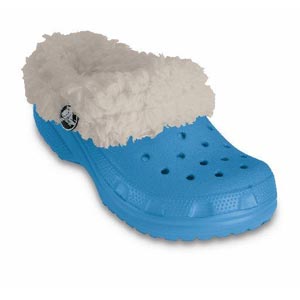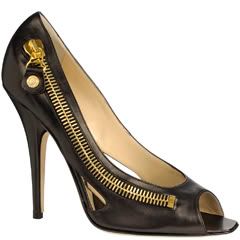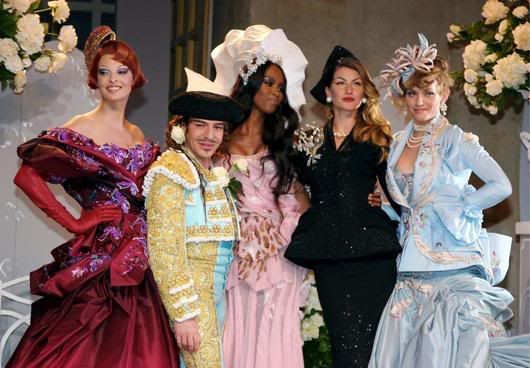
Makeup Alley
It would be a nice idea if those of you with hot beauty tips could share them here (that's the comments below, but obviously make up alley, too, because that's what it's for.)
Friday, 9 November 2007
Things I like
Posted by
Linda Grant
at
16:29
3
comments
![]()
![]()
![]()
![]()
Labels: Face body hair, Things I like
Hillary and the shoe question

The Guardian writes:
. . . the journalist and women's rights activist Gloria Steinem says support for Clinton generally breaks along class lines. "They say you can tell a Hillary supporter by her shoes. If she is wearing nurse's shoes, or waitress's shoes, she supports Hillary," Steinem told me. "Overwhelmingly, women of colour, single women, poor women who have a better sense of their interest in issues, are for Hillary."
Posted by
Linda Grant
at
15:48
1 comments
![]()
![]()
![]()
![]()
High heels win
The empowering qualities of high heels won the Tuesday poll, by 55 per cent of the vote.
My thoughts on the subject are contained in this Telegraph piece which is not on-line:
This past year something has gone badly wrong with shoes. We are supposed to be a nation of shoeaholics, vain spendthrifts who cannot make it through a pay day without running out to buy a pair of Manolos or Jimmy Choos. But in the Autumn I made a dozen tours of shoe shops – Russell and Bromley, Kate Kuba, LK Bennett, Office, even Clarks as well as the over-stocked shoe departments of Selfridge’s and Harrods - without finding anything to buy. Whether it was Carvella or Chanel, before me were rows of towering fetish footwear, monstrously high heels atop thick platforms. I am only five feet five and not averse to acquiring the additional height, but I cannot walk in these shoes. When I say I cannot walk, I do not mean that I am unable to balance. Of course I can walk in high heels, but when I say walk, I mean the kind of walking you do to go about your everyday business, not totter a few feet across the floor of a shoe shop. Walking without searing pains in my ankles and creaking knees.
This is what I mean by walk: walk down the stairs from my bedroom, walk to the bus stop, wait for the bus, get on the bus, stand until it reaches the tube station. Walk down the steps to the platform, wait, get on the tube, stand again, get onto the escalator, then along the street a few blocks to my first destination. In average day, I would expect to spend a good hour walking from one place to another. This is not exercise, it’s everyday life. But at the end of that average day walking in heels my back is spasming, my calves are aching and the evening must be spent soaking in Radox.
When I look around the streets, I do not see anyone wearing the shoes in the windows of the shoe shops. I see women wearing flats, I see them wearing boots with chunky heels, I see them wearing trainers, but I don’t see anybody at all running for a bus in this season’s shoes. At a catwalk show in the Autumn, I looked at the front row of fashion editors and saw a line of skinny jeans worn with boots or flats. No platforms, no high heels.
So what are they for? Are they car to bar shoes, designed only for a night out? Fine, if they are, I am not immune to buying the kinds of shoes one knows one only has to stand in for a few hours at a party. I have these shoes. But what are we supposed to wear the rest of the time? In my dozen trips round the shops this season, I would sometimes spy a pair that I could walk in, and on every occasion, I was told, with a puzzled look on the face of the assistant, that they had sold out very quickly, which would surprise her because, as she admitted, they weren’t the hot new shoes of the season, and it was funny that they went so fast. Finally at Kate Kuba in Sloane Square a young man admitted that this season’s shoes were so outré that anything wearable sold out at once.
We are in a devilish pickle since the demise of kitten heels. Between flats and platforms, there is nothing. You have to wait until the summer when wedges reappear, those feet friendly shoes whose banishment by fashion diktat has to be imminent, because it seems to be a rule that if you can walk in shoes, there must be something the matter with them. A clever marketing exercise was done on Manolos, when Sara Jessica-Parker told interviewers that hers were as good as fleecy slippers, ‘I could run in these!’ she said, and there she would be, on our tv screens racing along through the streets of New York. And then you went down to your nearest Manolo store and tried some on and their freakishly narrow proportions meant you could barely get your feet into them. As Joan Burstein, the legendary owner of Brown’s, the South Molton Street shop, and first employer of the teenage Manolo Blahnik, admitted to me, Manolo’s are not comfortable if you have wide feet.
I love the look of beautiful shoes and for this reason, every morning, as soon as I turn on my computer, I click on to the delicious site of Manolo the Shoeblogger, the anonymous New Yorker who combines a fascination with shoes with a witty and erudite writing style. He views shoes both as works of art, and as artefacts which should be made by the master craftsman. ‘Do not wear cheap shoes!’ he enjoins his readers. But cheap or dear, if the shoe does not fit you cannot wear it.
The backlash against unwearable shoes has come in the form of its opposite: the eminently wearable but utterly hideous shoes. If you want sensible footwear, buy ugly Uggs, or those disgusting luridly-coloured rubber shoes with holes in them, called Crocs, which were originally designed for wading into ponds to clean out the algae.
The unnerving popularity of Uggs and Crocs is testament to women losing their patience with contemporary shoe design. I find my feminist hackles rising when I look at shoes which more and more resemble a sadistic attempt to reinvent Chinese foot-binding. My mind fills with dark conspiracy theories: that the emancipation of women is being punished with exquisite pain applied to the feet, followed by blisters and bunions. And then I look at the Uggs and the Crocs and I ask why we are forced to make a choice between Crippling Beauty and Slouching Beast.
There is no other part of the body we would surrender to ugliness or pain. We don’t wear jeans that make our bums look big (or don’t if we have any sense), we don’t squeeze ourselves into too-tight clothes, yet is there a fashion conscious woman who does not have at least one pair of shoes that don’t fit and never will fit because they were half a size too small when we bought them, in the hope that somehow they could be forced to stretch?
When did shoes get so absolutely impossible? Until the 1950s, women wore closed-toe shoes with a low heel. They wore lace-up brogues to work and thought no more of it. In 1955 the stiletto heel arrived from Italy. The tall, thin heels transmitted a large amount of force in a small area, and had to be strengthened by a metal rod and a metal or hard plastic tip. The great pressure transmitted through such a heel (greater than that exerted by an elephant standing on one foot, apparently) alters the posture causing the hips sexily to sway out but also causes back pain. By the mid-Sixties, round-toed shoes with low heels replaced them, as dresses became shorter, and we should be seeing a return to these kinds of shoes with this season’s Sixties, silhouette, except we are not. High platform heels reappeared in the Seventies, along, briefly, with wedges. High heels reappeared in the Eighties, as a counterpoint to the power suit, then in the Nineties were replaced by the hideous clumpy shoes, so beloved of teenage girls.
Yet the lure of high heels won’t leave us alone. I sought a master class in the wearing of heels from novelist Susie Boyt who never wears anything else and does not own a single pair of flats. She bought her first pair of heels (Robert Clergerie in black suede) on Bond Street in 1990, after taking time out from university. ‘It made going back doable,’ she says. ‘It might not have been possible had I not bought them. I like the height they give you, I feel much more me in high heels, my best self, and I don’t feel like myself when I haven’t got them on. ’ She learned that wearing heels is ‘a discipline, like going to the gym. I wouldn’t admit to feeling pain. Your body gets used to it. I always wear bare feet at home and I did masses of dancing when I was younger which makes it easier to wear heels. There’s a lot of exercises you can do which make high heels not hurt. If I didn’t do them, they would hurt more. And I do take them off on buses and in cinemas and restaurants.’
I asked her if she could run in them, as Sarah Jessica-Parker claimed she could do in Manolos. ‘I could run if I was chased,’ she said. ‘I once walked from Crouch End to Hyde Park Corner in a pair of four inch suede strappy sandals. It must have been seven miles and I didn’t have any pain. On the other hand I know people who only wear heels and have mild, heel-induced agoraphobia. They won’t walk to the end of the road or want to take taxis three blocks because they can’t walk in their shoes and they're always grumpy. That's no way to live.’
I remain ambivalent about this you-must-suffer-to-be-beautiful philosophy, though I greatly admire Susie’s fortitude and dedication to her true self. I’m not sure that it is mine, though. Many years ago I had a pair of perfect shoes. They were pink suede wedges with pink suede ties, like Grecian sandals that wound around the ankles. They were beautiful and functional, I could walk in them and run them and wherever I went, people called out, ‘Beautiful shoes!’ Carelessly, I threw them away when they wore out. I was young and I believed that ahead of me was a whole life-time of beautiful, functional shoes; that you just had to go to Dolcis or Ravel or Saxone, and there would be another pair, waiting. My beautiful pink suede wedges were like my first pair of ice skates: in them I could glide away, effortlessly dancing, swooshing and twirling.
I was young and I was poor and I only had three pairs of shoes. Now I am old and rich and I have forty pairs of shoes and some of them may be beautiful but I can’t walk in them, let alone glide or swoosh or twirl, and some I could climb Mount Everest in, but they are never taken further than the local shops because they are hideous. Is fashion really without mercy, or compromise?
Posted by
Linda Grant
at
09:09
23
comments
![]()
![]()
![]()
![]()
Labels: Democracy, Opinions, Published work, Shoes
Thought for the day

The pedant who considers fashion idiotic on account of its transitoriness commits a sin against life. Fashion is in fact a symbol of life itself, which showers its gifts fickly, wastefully, without calculating timidly whether the effort stands in a sensible relationship to that which is achieved. Nature strews thousands of seeds everywhere. Perhaps one will sprout. It is precisely this extravagance of thought, this eternal beginning, this colourful richness that makes fashion so pleasurable.
August Endell
Posted by
Linda Grant
at
07:47
1 comments
![]()
![]()
![]()
![]()
Labels: Thought for the day
